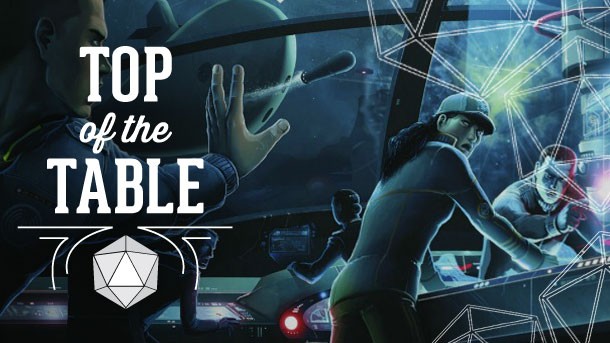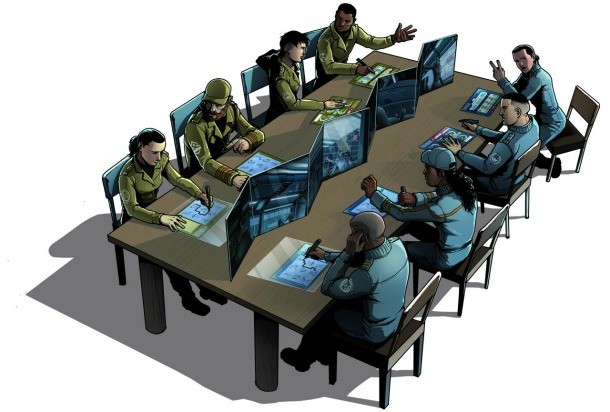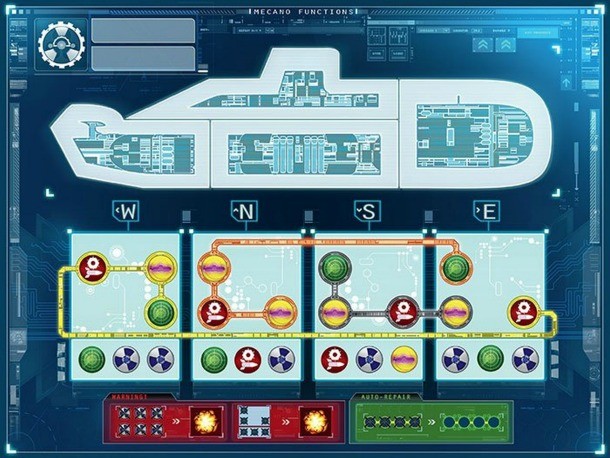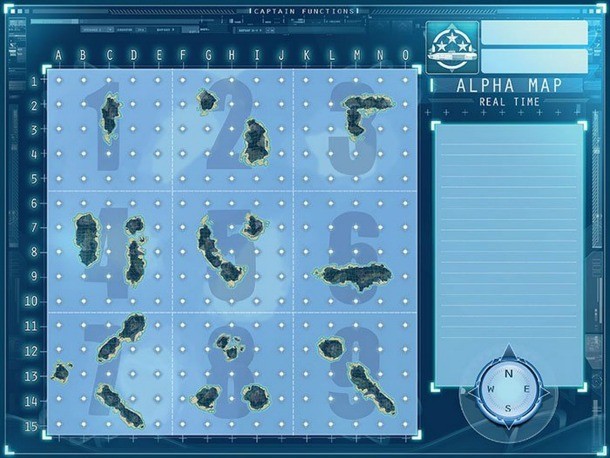Top Of The Table – Captain Sonar

One of my favorite trends unfolding in the tabletop scene right now is the reimagining of what components and ideas can formulate a tabletop game. While there are plenty of awesome traditional card and board games releasing in recent months, games like Captain Sonar are stretching the boundaries of expectation. With no dice, cards, or even a traditional board, Captain Sonar manages its gripping gameplay with little more than a few dry-erase markers, some laminated sheets, and a massive screen that separates one team from the other.
In this new game from designers Roberto Fraga and Yohan Lemonnier (and published stateside by Asmodee), players take on the role of submarine officers, floating silently through the deep on the hunt for the enemy team’s sub. Captain Sonar employs a team-based cooperative approach; up to eight players can play together, splitting off into two teams of up to four. On each team, specific roles must be fulfilled, and the gameplay is different depending on your role.
The captain announces course directions, and determines when major systems will be used. A first mate tracks when systems are ready for use, and attempts to anticipate the needs of his or her captain. The radio operator desperately listens to the course changes of the enemy captain, and tries to track them. And the engineer attempts to hold together a fragile ecosystem of reactors and circuits that keep the submarine operational. The variety inherent to these four roles has enormous potential for replay, ensuring that every player can enjoy getting to know different strategic roles within the game.

In an eight-person game, every player role on each team has a designated place to sit at the table
No matter your role, Captain Sonar eschews traditional card and dice mechanics for an innovative use of erasable markers and laminated sheets, each of which corresponds to your specific task. The radio operator draws lines on a floating transparent sheet, and then tries to track enemy movement by moving that overlay sheet into different positions on top of a map of open sea and blocking islands. At the same time, the engineer makes hard choices about which systems break down, marking on his or her sheet an ever more complex array of problems within the sub. Each player marks their sheet in distinct ways. No matter your role, the marks you make on your role sheet contribute to the position, functionality, and situational awareness of your team, and I love that everyone contributes in a meaningful way.
Between the teams, a massive cardboard divider runs the length of the table. You can see the enemy team (your other friends) on the other side of the table, and hear what they say to each other, but you can’t see their sheets, so you’re constantly trying to figure out where they are, and what they might do next. Without dice or a random deck of cards, everything in Captain Sonar is directly determined by your actions and those of your teammates. And communication is absolutely essential to the efficient operation of your submarine.
Captain Sonar’s complexity emerges through the additional actions that a crew might attempt beyond the basic operation and movement of the sub. Drones are sent out to narrow the search field where the enemy might be hiding. Sonar further tracks disturbances in the water. When in danger, the Captain might enact silent running, leaving the enemy radio operator with a blank space on their map. Torpedoes and mines can be strategically deployed in the style of the classic game Battleship (Torpedo launched! Impact in C4!), once you think you’ve figured out where the enemy team is hiding out. And when underwater repairs have become too dangerous, you might even surface your sub, dangerously exposing your team, but giving a chance to reset your ship’s systems and chart a new course. During play, there’s a constant tension as you try to outwit your opponents while simultaneously being careful not to give away your own position.

Each player uses an included marker to note changes to the submarine on their laminated sheet
Even once you master the four roles, Captain Sonar keeps things interesting with multiple maps and scenarios. On one map, your sub is floating through the Arctic, and can only surface in open water holes if it doesn’t want to take ice damage. In another map and mode, both teams move through an already active minefield. Each map has its own obstacles and potential courses, so the radio operator and captain have designated sheets that correspond to each scenario.
The game’s other twist is the availability of both turn-by-turn and real-time play variants. In turn-by-turn, the action moves slower, but allows for more strategic decision making. In the far more complicated and frantic real-time mode, communication must be fast and precise, as both teams are constantly moving their submarine, repairing, and firing off attacks without waiting for the other team. The two modes of play are accomplished simply by flipping over your laminate sheets to the opposite side; it goes without saying that it is very important that everyone is conscious of which mode is being played; confusion sets in very quickly if one team member has flipped to the wrong side, as one of my players mistakenly learned in one playtest. The two modes of play feel dramatically different, but both can lead to tense and rewarding sessions.

The captain draws his submarine's route on this laminate sheet, but the map changes for each scenario
No matter your mode of play or scenario, a game of Captain Sonar takes around an hour to play, though new players may require some instruction ahead of time; once the game starts, it’s hard to communicate the specifics of how to play, since the enemy team will seize on any information offered. I recommend that when playing with a mostly new group of players, consider running several practice turns before diving into the main game, ensuring that everyone knows what to do within their role. Captain Sonar really does play best with a full team of eight players; the rules offer suggestions for how to break up the various roles with fewer players, but much of the adrenaline is lost with fewer players shouting out directions, repair requests, or torpedo ready cries. Finally, perhaps it goes without saying, but the focus on marking sheets and setting up a visual barrier demands a playspace and table of significant size, especially if playing with a full eight-person complement.
Despite the seemingly serious naval warfare theme, Captain Sonar brings with it a raucous and lighthearted fun that is refreshing, and unlike many cooperative games, it practically demands that every player remain autonomous and make their own decisions for the good of the team. My experience suggests that after a first game, your playing group is likely to shuffle teams and roles, and dive right back in for another attempt.
Looking for something with a lighter tone? My last Top of the Table column examined the excellent Junk Art – one of my favorite family-friendly games in a long time. You can check out that recommendation and all the others at the Top of the Table hub by clicking on the banner below. And as always, let me know by email or Twitter if there is a game you’d like to see featured in the future.


Get the Game Informer Print Edition!
Explore your favorite games in premium print format, delivered to your door.
- 10 issues per year
- Only $4.80 per issue
- Full digital magazine archive access
- Since 1991









